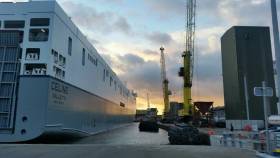Displaying items by tag: Celine Christening
Big Day Ahead As World's Largest Short-Sea RoRo Vessel MV Celine to be Christened In Dublin Port
#DublinPort - A big day awaits Dublin Port and major customer, CLdN ro ro SA as their newbuild MV Celine, the world's largest short-sea ro-ro ship arrived in the port today in advance of tomorrow's christening ceremony, writes Jehan Ashmore.
The giant MV Celine of 74,000 gross tonnage will be christened and adopted by her Godmother,Geraldine O'Reilly wife of Dublin Ports CEO Eamonn O'Reilly at a ceremony to be held at Ocean Pier within Alexandra Basin. This is where a purpose-built flexible ro-ro ramp linkspan was installed in recent months to accommodate the requirements of the 234m long Celine.
Since Celine's introduction in October, the ship has added considerable capacity for Irish exporters with greater flexibility by trading with markets in continental Europe, in particular, given the backdrop of post-Brexit. More recently a sister, Delphine, joined the service connecting Dublin with Rotterdam, Netherlands and Zeebrugge from where the ship arrived from Belgium this morning.
The new berth infrastructure in Dublin Port permits the unloading and discharging of Celine's impressive 8,000 freight lane metre capacity. In addition to 600 freight units, easily surpassing the largest Irish Sea ro-ro ferry currently operating through the port to the UK.
The sisters can handle a wide range of cargoes, unaccompanied trailers, tank containers, project cargo, new cars and a capacity for 12 driver accompanied units. The ro-ro ships will also include a North Sea link from Belgium to the UK. Luxembourg based CLdN ro-ro SA also operate an extensive route network linking mainland Europe with Scandinavia and Iberia.
The South Korean built Celine is a clear indicator of increasingly larger tonnage that is expected to use the port. Construction of phase one of the Dublin Port Masterplan is already underway with the Alexandra Basin Redevelopment (ABR) project that will enable larger ships to dock in port following dredging and realligned quays.




























































